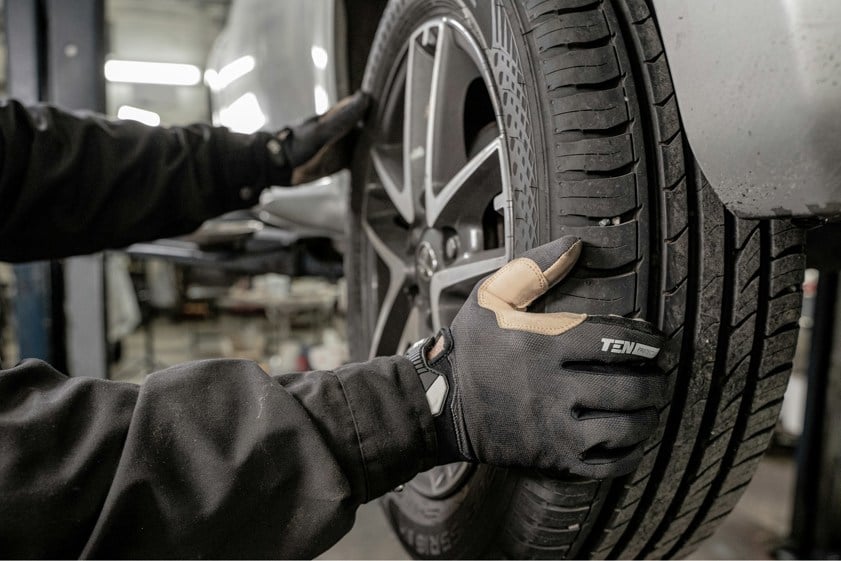
Locking wheel nuts are one of those things that many drivers don’t think about. Whether you’re leasing or buying a car, it’s worthwhile understanding what locking wheel nuts do and how they work.
Trust us, in the long haul, it can save you a lot of time, effort, and stress.
In this guide, we’ll explore everything you need to know about locking wheel nuts, including what they are, whether they matter, and how to remove them. Let’s get started:
A locking wheel nut is a small, metal tool that’s added to your wheels (usually by the manufacturer) to secure them and prevent wheel theft.
Unlike a standard nut, locking wheel nuts have a unique pattern that requires a matching key to remove them. Without this key, it's nigh-on impossible to remove the wheels, deterring potential thieves.
If you’re worrying about where you’ve put the key, don’t worry. It’s provided with the car and is usually kept with the spare wheel, in the glove box, or in the boot.
Depending on your car, the number of locking wheel nuts will vary, but you’ll usually find one locking nut per wheel. If you’ve got issues with the wheel and need to take it off, you’ll obviously need to remove the locking nut (which can be stressful if you’re unaware of what it is).
Think of a locking nut like a padlock for your wheels. If you’re encountering one for the first time, it can be stressful, so take some time to do a bit of research, and you’ll soon be driving off into the sunset in no time (literally).

Yes, it’s likely that your car will have a locking wheel nut. Most modern cars come with locking wheel nuts as standard, particularly if the car has alloy wheels.
If you’re leasing a new car (or a used car, in some cases), it’s extremely likely that the car will have locking wheel nuts. However, you can still check for yourself:
- Take a look at your wheels - If you notice a nut on each wheel looks a bit different, that’s a locking wheel nut.
- Look for the key - If you can’t tell from the above, try to find the locking wheel nut key in the glovebox, with the spare wheel, or in the boot.
- Read the handbook - The last port of call should be to check the car’s handbook, which will categorically tell you if it has a locking wheel nut.
If you’re leasing a car with Nationwide Vehicle Contracts and are unsure whether your car has locking wheel nuts, give us a call on 0345 811 9595 and we’ll be happy to assist
Hopefully, you’ll never need to use your locking wheel nut key, but if you do, there are a few places in your car where it could be stored:
- Glovebox - Often in a pouch or plastic bag
- With the spare tyre - Lift the panel in your boot to reveal the spare tyre and the key
- In the boot - It may be in a storage compartment in the boot
- Centre console or door pockets - Occasionally popped in during handover
For lease customers, check your delivery paperwork or ask your leasing provider. When you find the key, don’t leave it in an insecure place. Keep it somewhere safe and accessible in case of emergencies.

So, you’ve found your key. Now it's time to get down to business and remove a locking wheel nut.
First things first, if you’re not confident doing this sort of thing, let an expert do the job. If you’re leasing, any VAT-registered garage will be acceptable.
If you want to do it yourself:
- Park on level ground and make sure the handbrake is on
- Locate the locking wheel nut on the wheel
- Attach the key to the nut and make sure it’s lined up properly
- Connect your wrench to the other end of the key
- Loosen the nut by turning it anti-clockwise
- Once it's loose, continue removing it by hand
If you’re leasing a car, locking wheel nuts won’t be the first thing on your mind (if they are, are you okay?).
However, they’re important. They come as standard with most lease cars and will play a crucial role if you ever need to replace your tyres, you're part of a roadside emergency, or when returning your vehicle at the end of your lease contract.
When leasing, just make sure you know where the locking wheel nut is stored as soon as you take delivery of the vehicle. Keep it in a safe and secure place, so you know where it is in case of an emergency.
Need more practical motoring advice? Check out the Tips, Tricks and Hacks section of our blog, where we cover everything from car security to driving advice.

